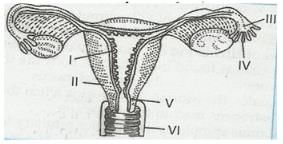Multiple Choice Questions (MCQs): Human Reproduction - NEET MCQ
20 Questions MCQ Test - Multiple Choice Questions (MCQs): Human Reproduction
The glandular tissue of each breast is divided into 15-20_____.
In sectional view of female reproductive system, which one is correctly labeled?


The anterior most portion of the external genitalia of female which is fatty area covered with skin and pubic hair is called______.
Which of the following is not the function of a placenta?
The middle layer of uterus is thick muscular myometrium that help in_________.
Primary germ layers are_______,________ and__________.
A scientist was looking at using different hormones in the blood as a marker for pregnancy. Which of the following hormones will not be ideal for this?
How many sperms are formed by 4 primary spermatocytes?
The developing sperms are nourished by:
Which of the following control the function of Sertoli cell?
A human female is born with a million of primary oocytes at the time of birth. How many eggs get a chance to mature?
Testosterone is secreted by____.
What happen during fertilisation after all the sperm reach close to ovum?
A Human female reaches menopause around the age of_____.
Which one is the most likely reason of not occurring regular menstrual cycle?
Shortest phase of the menstrual cycle is______.
Finger-like projections appear on the trophoblast after implantation is called?
Which of the following is formed first out of the following in growing foetus: hairs, limbs and digits, heart, eye lids?
The testes are situated outside the abdominal cavity within a pouch called scrotum. This is necessary as:














